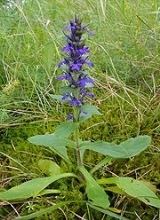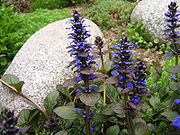
Ajuga genevensis
Encyclopedia
Ajuga genevensis is a herbaceous flowering plant
native to Europe
. It is less common than its relative, Ajuga reptans
(common bugle).
(flowering between April and July) growing to a height of between 10 and 30cm. Evergreen
, it has long-stalked, obovate, basal leaves which are shallowly lobed or toothed.
It has an upright stem with flowers arranged in dense, terminal, spike-like inflorescences. The flowers are usually violet-blue, though can be pink or white, and the uppermost flowers are often flushed with blue. When pink, it is sometimes known as "pink beauty", and when white, it is sometimes known as "alba". The flowers have short upper-lips with protruding stamen
s and pistil. The plant sometimes suffers from Erysiphe biocellata, a type of mildew
.
 Ajuga genevensis is a less common relative of Ajuga reptans
Ajuga genevensis is a less common relative of Ajuga reptans
, the Common bugle, though it is common for the two plants to interbreed, as well as with Ajuga pyramidalis
, the pyramidal bugle, producing hybrid offspring that are very similar.
and bract
s.
, France
, Italy
, Britain
and from Macedonia to Caucasia
. It can also be found growing wild in North America
as a result of seeds that have escaped from gardens. It is used as an ornamental plant in gardens worldwide, where it used in edges due to its slower spread compared with A. reptans.
Flowering plant
The flowering plants , also known as Angiospermae or Magnoliophyta, are the most diverse group of land plants. Angiosperms are seed-producing plants like the gymnosperms and can be distinguished from the gymnosperms by a series of synapomorphies...
native to Europe
Europe
Europe is, by convention, one of the world's seven continents. Comprising the westernmost peninsula of Eurasia, Europe is generally 'divided' from Asia to its east by the watershed divides of the Ural and Caucasus Mountains, the Ural River, the Caspian and Black Seas, and the waterways connecting...
. It is less common than its relative, Ajuga reptans
Ajuga reptans
Ajuga reptans, commonly known as Blue bugle, Bugleherb, Bugleweed, Carpetweed, Carpet Bungleweed, Common bugle, or Burgundy lace, is an herbaceous flowering plant native to Europe. This plant is often used as an ornamental plant. It is invasive in parts of North America.-Description:The bugle has...
(common bugle).
Description
Ajuga genevensis is a perennial plantPerennial plant
A perennial plant or simply perennial is a plant that lives for more than two years. The term is often used to differentiate a plant from shorter lived annuals and biennials. The term is sometimes misused by commercial gardeners or horticulturalists to describe only herbaceous perennials...
(flowering between April and July) growing to a height of between 10 and 30cm. Evergreen
Evergreen
In botany, an evergreen plant is a plant that has leaves in all seasons. This contrasts with deciduous plants, which completely lose their foliage during the winter or dry season.There are many different kinds of evergreen plants, both trees and shrubs...
, it has long-stalked, obovate, basal leaves which are shallowly lobed or toothed.
It has an upright stem with flowers arranged in dense, terminal, spike-like inflorescences. The flowers are usually violet-blue, though can be pink or white, and the uppermost flowers are often flushed with blue. When pink, it is sometimes known as "pink beauty", and when white, it is sometimes known as "alba". The flowers have short upper-lips with protruding stamen
Stamen
The stamen is the pollen producing reproductive organ of a flower...
s and pistil. The plant sometimes suffers from Erysiphe biocellata, a type of mildew
Mildew
Mildew refers to certain kinds of molds or fungi.In Old English, it meant honeydew , and later came to mean mildew in the modern sense of mold or fungus....
.
Relatives

Ajuga reptans
Ajuga reptans, commonly known as Blue bugle, Bugleherb, Bugleweed, Carpetweed, Carpet Bungleweed, Common bugle, or Burgundy lace, is an herbaceous flowering plant native to Europe. This plant is often used as an ornamental plant. It is invasive in parts of North America.-Description:The bugle has...
, the Common bugle, though it is common for the two plants to interbreed, as well as with Ajuga pyramidalis
Ajuga pyramidalis
Ajuga pyramidalis is a flowering plant of the genus Ajuga in the family Lamiaceae.It is a native plant in Europe.-References:...
, the pyramidal bugle, producing hybrid offspring that are very similar.
Varieties
There are also several variants of Ajuga genevensis such as A. genevensis var. arida (a variety with short grey hairs found in mountain meadows) and A. genevensis var. elatior (a mountain plant with randomly hairy stems). Both varieties vary slightly in the shape and size of the leavesLeaf
A leaf is an organ of a vascular plant, as defined in botanical terms, and in particular in plant morphology. Foliage is a mass noun that refers to leaves as a feature of plants....
and bract
Bract
In botany, a bract is a modified or specialized leaf, especially one associated with a reproductive structure such as a flower, inflorescence axis, or cone scale. Bracts are often different from foliage leaves. They may be smaller, larger, or of a different color, shape, or texture...
s.
Distribution
Ajuga genevensis are found on the edges of dry woods, as well as in thickets and grasslands. It is found at various locations around Europe including SwedenSweden
Sweden , officially the Kingdom of Sweden , is a Nordic country on the Scandinavian Peninsula in Northern Europe. Sweden borders with Norway and Finland and is connected to Denmark by a bridge-tunnel across the Öresund....
, France
France
The French Republic , The French Republic , The French Republic , (commonly known as France , is a unitary semi-presidential republic in Western Europe with several overseas territories and islands located on other continents and in the Indian, Pacific, and Atlantic oceans. Metropolitan France...
, Italy
Italy
Italy , officially the Italian Republic languages]] under the European Charter for Regional or Minority Languages. In each of these, Italy's official name is as follows:;;;;;;;;), is a unitary parliamentary republic in South-Central Europe. To the north it borders France, Switzerland, Austria and...
, Britain
Great Britain
Great Britain or Britain is an island situated to the northwest of Continental Europe. It is the ninth largest island in the world, and the largest European island, as well as the largest of the British Isles...
and from Macedonia to Caucasia
Caucasus
The Caucasus, also Caucas or Caucasia , is a geopolitical region at the border of Europe and Asia, and situated between the Black and the Caspian sea...
. It can also be found growing wild in North America
North America
North America is a continent wholly within the Northern Hemisphere and almost wholly within the Western Hemisphere. It is also considered a northern subcontinent of the Americas...
as a result of seeds that have escaped from gardens. It is used as an ornamental plant in gardens worldwide, where it used in edges due to its slower spread compared with A. reptans.
External links
- Ajuga genevensis in the USDA database

